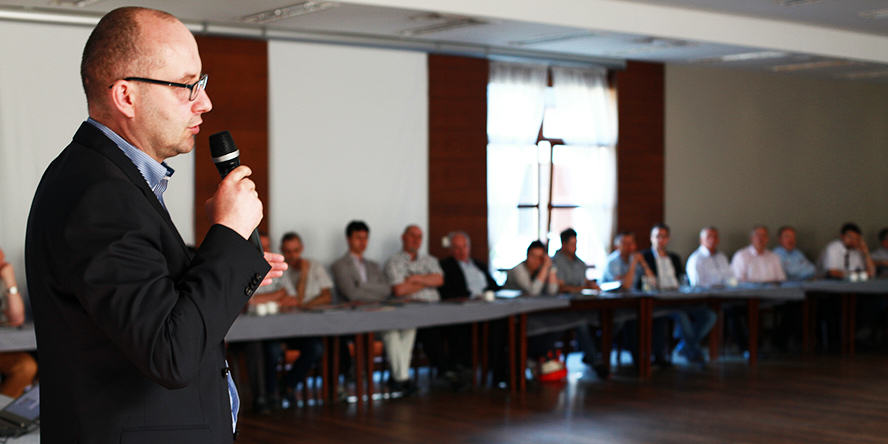
Production safety is one of the most important elements of the functioning of industrial plants. Wherever people deal with combustible dust, they should be aware of the risk of explosion and fire. This knowledge is the first step that allows you to significantly reduce the likelihood of a disaster. The question is how to gain that knowledge?
The best practices are safety audits and training. In the latter case, however, a serious problem appears – theoretical lectures are not enough to make training participants aware of the seriousness of the threat they meet every day. As a consequence, they disregard it and do not follow the safety procedures, which often leads to serious accidents. A possible solution consist in a combination of theoretical knowledge and practical one.
It is precisely the practical aspects that were the most important element of the training prepared by the engineers of WOLFF GROUP, together with Pfeifer & Langen Poland S.A., for several dozens of key employees of Pfeifer & Langen’s sugar refineries.
“Sugar refineries conducting technological processes during which considerable quantities of sugar dust arise are particularly concerned with the subject of explosion protection. Advancing knowledge in the field of explosion protection and fire safety plays an important role in ensuring a high level of safety in plants”, says Zbigniew Wolff, an explosion security expert in WOLFF GROUP.

Demonstrations dust explosions sugar
Anatomy of disaster
A very important element of the first part of the training called “Compendium of Information about Explosive Hazards” was a nearly 20-minute video showing the mechanics of the disaster at the Imperial Sugar Refinery.
“In the material, the staff’s errors and their consequences were explained step by step. In the sugar dust explosion that occurred in 2008, 14 people were killed and nearly 40 injured. The entire plant was completely destroyed. The disaster was caused by a series of errors that resulted from ignorance of staff”, comments Zbigniew Wolff.
Learn how the explosion at the Imperial Sugar occurred
A year before the tragic event, the authorities of Imperial Sugar Refinery, one of the biggest sugar refining and packing company in the USA, decided to encapsulate tightly one of the sugar conveyor belts. Stainless steel panels applied to that purpose were to protect the product from potential contamination. The housing, however, was not equipped with a dust extraction system, which, as it turned out, was a serious mistake.
Sugar lumps frequently blocked conveyor hoppers, which led to pouring of the product from the belt to the conveyor structure and the floor. This also resulted in the formation of dust clouds. The investigators conducting the inquiry came to the conclusion that such a situation must have also taken place on the day of the disaster.
On 7 February 2008, at ca. 7:15 pm, sugar dust encountered an ignition source – probably an overheated bearing of a conveyor belt – which led to the explosion. The explosion pulled apart the tunnel lining. The accumulated, settled sugar dust was raised and ignited by the accelerating ball of fire. Clouds of dust aroused thereby were the fuel for the chain reaction of the secondary explosion which moved through the building. Concrete floors broke loose, releasing tons of granulated sugar and powdered sugar straight into the flames. The picture below shows the immensity of the devastation caused by the sugar dust explosion.

Imperial Sugar Refinery after the explosion of sugar dust and fire
Demonstration of explosions
The second part of the meeting was a demonstration of sugar dust explosions from the sugar mills belonging to Pfeifer & Langen.
“When you personally experience the effects of an explosion, when you can feel a wave of explosion and see the ease with which the pressure breaks a decompression panel, you immediately gain respect for this phenomenon. I think that an hour show brings better results than dozens of hours of traditional training. It was precisely the reason for our decision to carry out such type of activity. We started with a demonstration prepared for the INDEX conference on process and explosion safety organized by our company. Subsequently, large corporations requested more and more frequently a performance of similar demonstrations at their plants”, says Bartosz Wolff, president of GRUPA WOLFF. “Raising awareness of explosive safety in industry is part of our mission”, he adds.
See the prepared demonstration of explosions
Sugar dust explosion in the filter protected decompression panel, without the use of the decoupling system, by following the propagation of explosion effects to the rest of the installation (an explosion in a smaller tank).
Sugar dust explosion in the filter protected decompression panel. On the pipeline used non-return damper, so there has been no outbreak of propagation effects through the pipeline to the rest of the installation.
Sugar dust explosion in the filter protection the explosion damping system (without explosion decoupling (isolation)).



